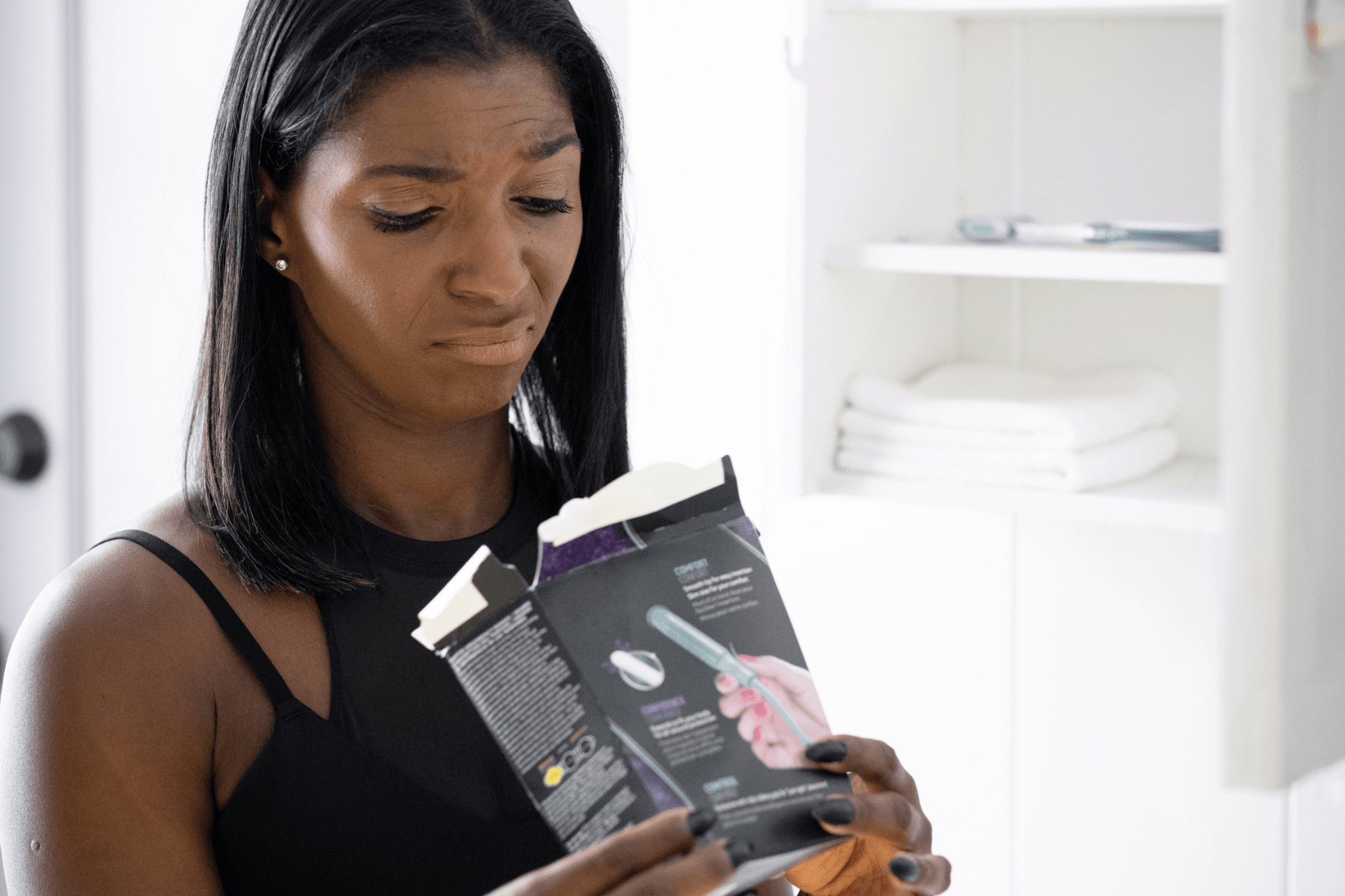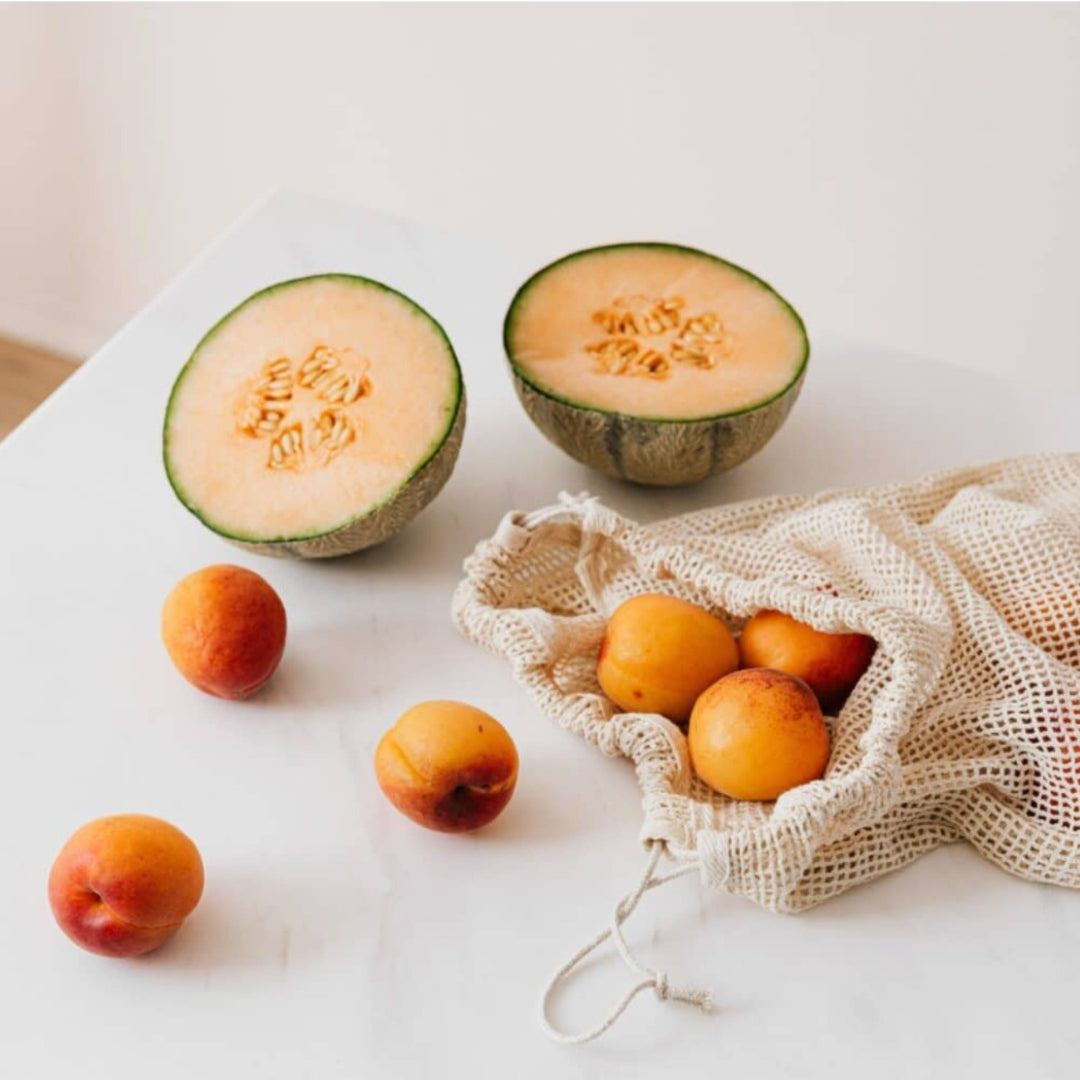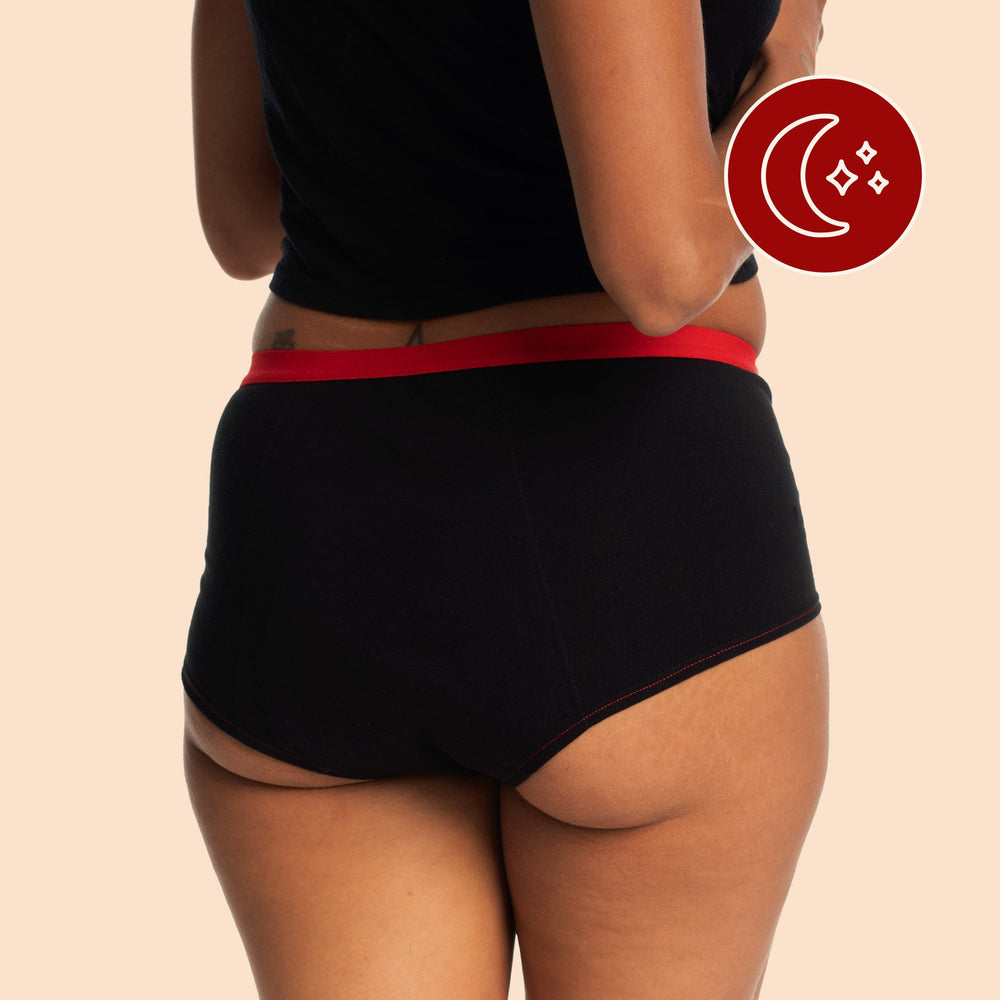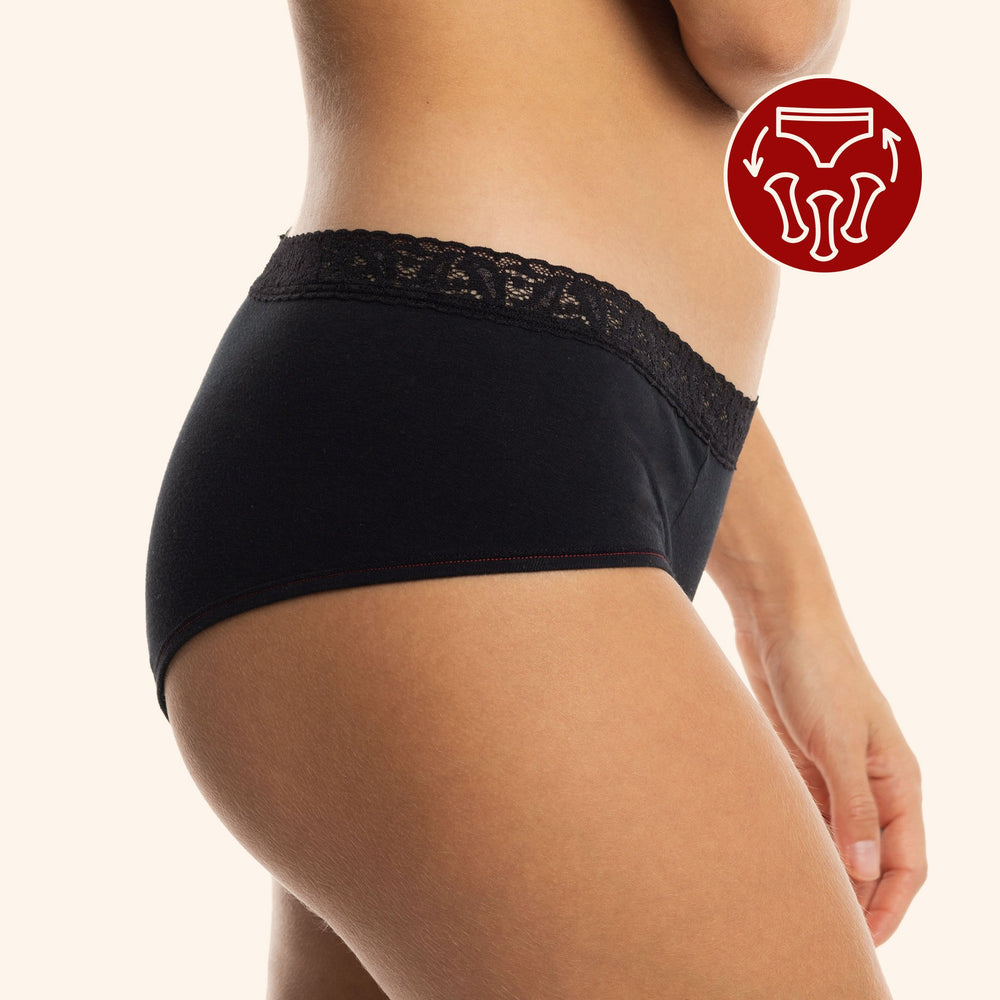After years of highlighting how many chemicals there are in disposable menstrual products, we felt pretty discouraged when we learned that Thinx, a reusable menstrual products company, was found to have been selling products containing PFAS (to get the whole story, skip to the end of the article).
When it comes to the environment and the health of people who menstruate, we're all on the same page. Together, we're pioneers working to save the planet and help menstruating people live their cycles with respect for both their bodies and the Earth.
It's ultra disappointing to see negligence in the design of products as intimate as menstrual undies, and it's even more unfortunate that the bad behaviour of a big industry player can taint the name of all the small companies that do things the right way.
In an article on the whole thing, I could sense the disappointment of a journalist who ended her column with this infinitely sad sentence: "So we don't really know which sanitary products contain PFAS or other harmful substances. An argument that does not reassure menstruating people, who do not know where to turn between disposable or reusable pads, menstrual panties, tampons or cups - each with its own risks. All we have to do is choose our poison..."
Ouch. That one hit went right to my core as an activist, entrepreneur, and passionate advocate for women's health.
Because not all menstrual undies are equal, and because tonnes of businesses from Quebec and elsewhere offer products of amazing quality -- products that are certified as PFAS free -- we want to offer you a little report on the subject so you can choose, with confidence, not your poison but your antidote. 🧪
Why are PFAS dangerous?
Perfluoroalkyl and polyfluoroalkyl chemicals, or PFAS, are made of synthetic organofluorinated chemical compounds with high chemical and thermal stability, which gives them many qualities such as non-stick, waterproof, and heat-resistant properties.
Since the 1950s, a lot of companies from a lot of industries (more on this later) have been trying to give their products these qualities, and consumer products with PFAS have been very popular over the years.
PFAS last a reeeeallllly long time in the environment and in our bodies because they never biodegrade and they like to accumulate. That's how they get their charming little nickname "Forever Chemicals."
They show up in the blood and organs of the whole world's human population, and there just as likely to be in wild animals as they are pets. Oh, and they're in glaciers and mountain air too.
PFAS contamination
PFAS include thousands of different compounds, many of which are recognized as toxic and eco-toxic by the Canadian government, including PFOA, PFOS, and long-chain perfluoroalkyl carboxylic acids (such as PFNA and PFDA), which are banned in Canada and many European countries in the manufacture, use, sale, and import of consumer goods.

PFAS contamination can have a lot of harmful effects on health (more on that below), and they can be directly ingested by, for example, eating something that contains them or indirectly ingested by, for example, touching something that contains them and then touching your mouth.
Studies also suggest the possibility of direct cutaneous absorption, certainly less intense than absorption by ingestion, but very real all the same. That's why it was so alarming to learn about the presence of these toxic substances in intimate products stuck to our vaginal mucosa.
What products contain PFAS?
PFAS are everywhere. Because they're in drinking water, bottled water, and airborne dust (blown, for example, from landfills), we all have them in our bodies.
And there's a whole collection of consumer goods that contain them too:
- foams used to extinguish fires
- non-stick surfaces, like Teflon, on kitchen accessories
- water- and oil-proof food packaging (popcorn bags, fast food packaging)
- waterproofing or stain-resistant products for textiles, carpets, and furniture (Gore-Tex and Scotchgard, for example)
- cosmetics and personal care products like makeup and, yes, some period underwear :(

Why are PFAS dangerous?
Here are a few quick facts to wrap your head around the nearly eternal and indestructible nature of PFAS.
The molecules they're made of are chains of carbon and fluorine atoms, one of the strongest chemical bonds. These compounds do not degrade easily.
Left alone in the environment, they can take over 1,000 years to break down. To eliminate them with heat, you'd need temperatures of over 1,500 degrees Celsius.
Nor can they be removed from water by iron filters or salt-softener systems, nor by biodegradation, micron filtration, sand filtration, ultrafiltration, coagulation, flocculation, clarification and oxidation by ultraviolet light (they have to be exposed to UV lamps all day to degrade), hypochlorite, chlorine dioxide, chloramine, ozone, or permanganate...
However, there are ways to filter them into water, including reverse osmosis, activated carbon filters, or ion exchange.
PFAS: Their effects on health
Several adverse human health effects have been observed in association with the presence of PFAS (including PFOS and PFOA) in high concentrations in the blood. These include:
- increased cholesterol in the blood
- increased uric acid levels in the blood (related to high blood pressure)
- increased risk of pregnancy hypertension and preeclampsia
- slowed growth of the fetus and child
- various liver, thyroid, reproductive and immune system disorders
- decreased immune response to vaccines in children
- potential effects on mammary gland and reproductive system development in children
Some studies have even linked PFAS to cancer, particularly that of the kidneys or reproductive system.

How does your body eliminate PFAS?
PFAS levels in the blood don't vary much over time since these toxic compounds can remain in the body for years. Studies show that it takes about 4 years to reduce the concentration of PFAS in an adult's blood by only half.
While PFAS are gradually eliminated over time, the vast majority of living things continue to absorb more than they eliminate, leading to accumulations.
Most types of PFAS leave the system naturally over time. They are eliminated through urine (in greater amounts in healthy people than in those with kidney disease) and through, you guessed it, menstruation.
And here we have some good news: people who menstruate eliminate more PFAS than those who don't thanks to their menstrual blood. Let us thank our cycles for this natural detoxing ability. :)
The Thinx story
All right, now that you know all about PFAS, let's look at what they were doing in Thinx's menstrual underwear.
It was Jessica Choy, a woman who'd been wearing Thinx since 2016, who one day became suspicious that they might contain PFAS.
To test her hypothesis, she bought new underwear from Thinx's site and had them directly delivered to the lab of the American Chemical Society's Dr. Graham Peaslee (also of the University of Notre-Dame). She did things that way so no one could question that the products came directly from Thinx.
Dr. Peaslee, a professor of applied nuclear physics, is known for having worked on PFAS in recent years. He was actually the researcher who revealed the presence of PFAS in food packaging in 2017, and he's also an advocate for a PFAS-free world in the movie Dark Water starring Mark Ruffalo (we see him giving a lecture on the subject).
In short, Dr. Peaslee's found a pretty significant amount of PFAS in Thinx's menstrual undies, this despite the company's claims in its ads and on its website that it doesn't use PFAS in its products.
After the results were made public, a consumer association called for further study and investigation, which wound up confirming Dr. Peaslee's findings.
In addition, further investigation also revealed the use of an antimicrobial agent (agION, composed of silver and copper) known to have harmful health effects.
Thinx has been in court since May 2022 and was finally ordered at the end of the year to pay nearly $5 million in compensation to customers who purchased their menstrual underwear between November 12, 2016, and November 28, 2022.
If you happen to be one of these people, you can be partially reimbursed (about $7 per pair) if you apply online or by mail by downloading the form. You must apply BEFORE APRIL 12, 2023.
Faced with these accusations, Thinx reacted by saying that it has never used PFA in its products, and it said that paying out the millions in compensation isn't an admission of guilt.
According to research by Mamavation, a website dedicated to conducting research and commissioning independent studies to expose consumer products containing toxic substances (including PFAS) and to recommend clean products, Thinx presented, in its defense, certifications that were not really its own (an OEKO-TEX certification for one of the raw materials used in its products and another in the name of another company involved in its manufacturing process).
However, the finished product is not certified, and the certification that Thinx claims is one of the OEKO-TEX certifications, the Standard 100, actually still allows for some concentration of some PFAS.
You can visit the official site to learn more about OEKO-TEX certifications.
After the Thinx scandal, Mamavation tested other menstrual underwear brands (it's fluorine that reveals the presence of PFAS). Here are the results (you can ind more detail on Mamavation's site):
- approximately 65% of the products tested (11 out of 17 underwear models, all brands) had detectable levels of fluoride in the inner OR outer crotch
- 3 of these brands had very high levels (100 to 940 ppm)
- 7 had very low levels of PFAS, suggesting cross-contamination during the manufacturing process or packaging
That's 6 out of 17 brands that were completely free of PFAS. Good news, actually, because it shows that PFAS are absolutely not necessary in the design and manufacture of effective menstrual panties. Which we at Mme L'Ovary already knew.
How can you choose PFAS-free products?
The Thinx scandal marked a sad day for the period underwear business.
Maybe the worst part was that after the lawsuits, Thinx and several other menstrual panty brands simply changed the description of their products on their websites (they didn't change the actual products). Because only a few PFAS are banned here and in several European countries, these brands cleared their names by simply removing the words "PFAS free" and other details from their promotional materials.🙁
The fight that women's health pioneers are waging for greener and better solutions for our bodies has taken a hit, because if you can't trust 65% of the companies, maybe it's better to stick to more traditional menstrual protection...
NO IT ISN'T! Mme L'Ovary is rolling up her sleeves and standing tall in the face of all this disappointment (but geez, do we ever get it). We're offering you products that REALLY ARE healthy for our bodies. No PFAS are used in the manufacturing of our underwear, and we don't use microbial agents or chemically treat the fabrics either.
In Mme L'Ovary's underwear, there's nothing to hide. Everything that touches your skin is 100% cotton, and the inner layers are made of cotton, elastane, PUL, and polyester (the polyester is OEKO-TEX Standard 100 certified).
We at Mme L'Ovary are proud to offer menstrual panties that are certified PFAS-free and nanosilver-free, for the well-being of your body and the planet.


So don't despair, activists and trailblazers. We're a brand that has answered your call and set the standard where it belongs: intimate products that are as healthy as they are comfortable and pretty. ❤️























